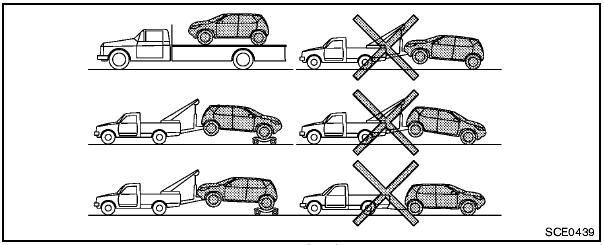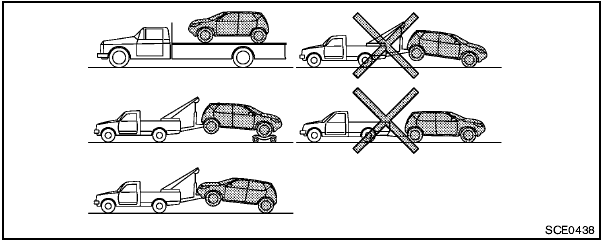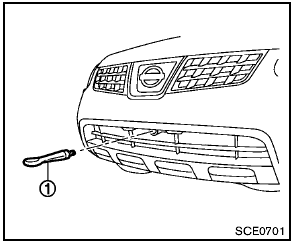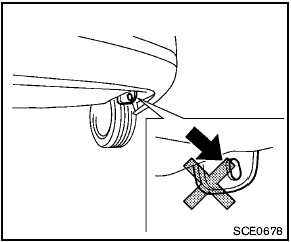Towing your vehicle
When towing your vehicle, all State (Provincial in Canada) and local regulations for towing must be followed. Incorrect towing equipment could damage your vehicle. Towing instructions are available from a NISSAN dealer. Local service operators are familiar with the applicable laws and procedures for towing. To assure proper towing and to prevent accidental damage to your vehicle, NISSAN recommends that you have a service operator tow your vehicle. It is advisable to have the service operator carefully read the following precautions.

- Never ride in a vehicle that is being towed.
- Never get under your vehicle after it has been lifted by a tow truck.

- When towing, make sure that the transmission, axles, steering system and powertrain are in working condition.
If any unit is damaged, dollies must be used.
- Always attach safety chains before towing.
For information about towing your vehicle behind a recreational vehicle (RV), see “Flat towing” in the “9. Technical and consumer information” section of this manual.
Towing recommended by NISSAN
All-Wheel Drive (AWD) models

All-Wheel Drive (AWD) models
NISSAN recommends that towing dollies be used when towing your vehicle or place the vehicle on a flatbed truck as illustrated.

Never tow AWD models with any of the wheels on the ground as this may cause serious and expensive damage to the powertrain.
Two-Wheel Drive (2WD) models

Two-Wheel Drive (2WD) models
NISSAN recommends that your vehicle be towed with the driving (front) wheels off the ground or place the vehicle on a flat bed truck as illustrated.

- Never tow Continuously Variable Transmission (CVT) models with the front wheels on the ground or four wheels on the ground (forward or backward), as this may cause serious and expensive damage to the transmission. If it is necessary to tow the vehicle with the rear wheels raised, always use towing dollies under the front wheels.
- When towing CVT models with the front wheels on towing dollies:
— Turn the ignition switch to the OFF position, and secure the steering wheel in
a straightahead position with a rope or similar device.
— Move the selector lever to the N (Neutral) position.
- When towing a CVT model with the rear wheels on the ground (if you do not use towing dollies): Always release the parking brake.
Vehicle recovery (freeing a stuck vehicle)

- Stand clear of a stuck vehicle.
- Do not spin your tires at high speed.
This could cause them to explode and result in serious injury. Parts of your vehicle could also overheat and be damaged.
Pulling a stuck vehicle

Front
Do not use the tie down hooks for towing or vehicle recovery.
Front:
Securely install the recovery hook 1 (stored in the luggage room) as illustrated.
Make sure that the hook is properly secured in the original place after use.

Rear
Rear:
Do not use the tie down hook to pull the vehicle.

- Tow chains or cables must be attached only to the main structural members of the vehicle or the recovery hook. Otherwise, the vehicle body will be damaged.
- Do not use the vehicle tie down hooks to free a vehicle stuck in sand, snow, mud, etc. Never tow a vehicle using the vehicle tie down hooks.
- Always pull the cable straight out from the front of the vehicle. Never pull on the vehicle at an angle.
- Pulling devices should be routed so they do not touch any part of the suspension, steering, brake or cooling systems.
- Pulling devices such as ropes or canvas straps are not recommended for use in vehicle towing or recovery.
Rocking a stuck vehicle
If your vehicle is stuck in sand, snow, mud, etc., use the following procedure:
1. Turn off the Vehicle Dynamic Control (VDC) system.
2. Make sure the area in front and behind the vehicle is clear of obstructions.
3. Turn the steering wheel right and left to clear an area around the front tires.
4. Slowly rock the vehicle forward and backward.
- Shift back and forth between R (Reverse) and D (Drive).
- Apply the accelerator as little as possible to maintain the rocking motion.
- Release the accelerator pedal before shifting between R and D.
- Do not spin the tires above 35 MPH (55 km/h).
5. If the vehicle cannot be freed after a few tries, contact a professional towing service to remove the vehicle.
See also:
Luggage hooks (Hardtop models)
WARNING
• Always
make sure that the cargo is
properly secured. Use the suitable
ropes and hooks.
• Unsecured cargo
can become dangerous
in an accident or sudden
stop.
CAUTION
Do not ...
How to use multi-function controller
Choose an item on the display using the main
directional buttons2 (or additional directional
buttons 6 with navigation system) or center
dial 3 , and push the ENTER button 1 for
operation.
If y ...
Window washer fluid
Type A
Type B
Fill the window washer fluid reservoir periodically.
Add window washer fluid when the low window washer fluid warning light illuminates
(if so equipped).
To fill the window was ...
